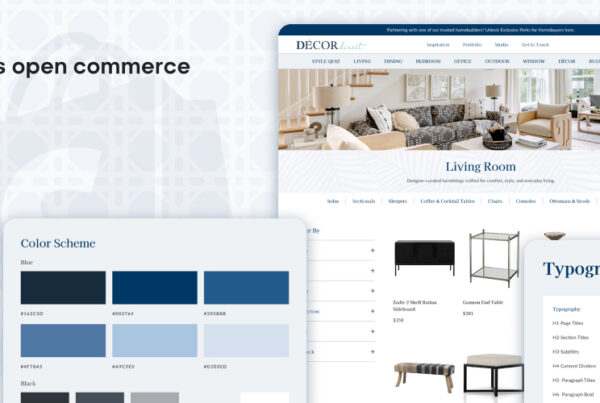Do you think you’re executing things right, but still not seeing any results? It’s time to evaluate your marketing strategy. An effective e-commerce marketing plan is necessary. But where do you even begin? We’ve got you covered.
We’ll go through creating a successful e-commerce marketing plan that will help achieve your goals and maximize sales. So pick up your favorite coffee and let’s explore!
Why You Need an E-commerce Marketing Strategy
As an e-commerce business owner, you may speculate why a marketing strategy is vital. The answer is easy: without one, your efforts might fall short and you’ll struggle to attract and retain customers.
A marketing strategy provides direction for all of your marketing efforts. It helps ensure that every action taken is intentional and contributes to the overall goal of increasing sales. Without a clear plan, your marketing tactics can lack focus and fail to make an impact.
A solid marketing strategy lets you differentiate yourself from competitors by promoting unique selling points that appeal with your target audience. This leads to increased brand recognition, customer loyalty and ultimately more sales.
Establishing a strategy requires understanding your target audience, what channels they frequent and creating engaging and compelling messages. By investing time into developing this critical foundation for success, you’ll set yourself up for long-term growth.
What are Your Goals?
Setting clear and achievable goals is crucial for any successful e-commerce marketing campaign. Without specific objectives, you won’t have a clear direction or know what to measure your success against.
Your marketing goals should be aligned with your entire business objectives. Whether it’s increasing sales, driving more traffic to your website, boosting brand awareness or improving customer engagement – make sure they are SMART (Specific, Measurable, Achievable, Relevant and Time-Bound).
Consider distinct goals you want to attain in the short and long-term. Are you launching a new product line? Do you want to increase repeat purchases from existing customers? Or do you simply want to boost revenue during the holiday season?
Once you’ve identified your main objectives, break them down into smaller milestones that will help guide your strategy implementation. For instance: how many new leads do you need each month? How much additional revenue do you need per quarter? How many social media followers would represent progress towards achieving greater brand awareness?
Remember that setting goals isn’t an exact science; instead think of it as a fluid process where adjustments can be made based on results achieved along the way.
Who is Your Target Audience?
Identifying your target audience is necessary for your e-commerce marketing strategy. Without comprehending who you want to reach, your efforts could be wasted on people with no interest in what you offer.
Start by defining the demographics of your ideal customer. Review age, gender, and location. This will help you create a buyer persona that represents your typical customer.
Beyond demographics, think about the psychographics of your target audience. What motivates them? What are their interests and values? How do they prefer to consume information?
By understanding both the demographic and psychographic characteristics of your target audience, you can tailor your messaging and channels accordingly.
It’s also important to consider where potential customers are in their buyer journey when crafting your e-commerce marketing strategy. Are they just starting to research solutions or are they ready to make a purchase? Understanding this will help distinguish which types of content and calls-to-action will be effective at each stage.
Ultimately, taking time to identify and understand who makes up your target audience is critical for maximizing sales through targeted e-commerce marketing efforts.
What Message Will Resonate With Your Target Audience?
When creating a marketing message that resounds with your target audience, there are things you need to remember.
Pain Points
Understand what your audience cares about most. What are their pain points? What motivates them? Once you have information, you can craft a message that speaks directly to them.
Clear and Concise
Messages should be clear and concise. Don’t confuse or overwhelm your audience with too much information. Stick to the key value propositions of your product or service and highlight how they solve the problems of your target audience.
Emotional Level
Use language that connects with your audience on an emotional level. People make decisions based on emotions, so if you can tap into those sentiments, you’ll more likely convert customers.
Authenticity
Another key factor in crafting a resonant marketing message is authenticity. Consumers today are savvy and can spot inauthenticity from a mile away. Ensure your messaging aligns with the values of your brand and your target audience.
What Channels Will You Use to Reach Your Target Audience?
In e-commerce marketing, deciding the best channels to reach your target audience is vital. There are options, each with benefits and drawbacks.
Wider Audience
Facebook, Instagram and Twitter lets you grasp a wider audience. However, ensure that your content resonates with your target audience and fits with each platform’s unique style.
Email marketing
Email marketing is another effective channel as you can send targeted messages straight to your subscribers’ inbox. Make sure that your emails are personalized and include clear calls-to-action.
Paid Advertising
Paid advertising through Google AdWords or social media ads allows you to target specific demographics based on their interests and behaviors. This can help increase visibility among potential customers who may not have discovered your brand otherwise.
Influencer Marketing
Influencer marketing involves partnering with individuals who have a significant following on social media platforms relevant to your industry or niche. This approach allows you to tap into their fan base while leveraging their credibility within the community.
Understanding which channels work best for reaching your target audience requires experimentation and analysis of data gathered from various campaigns. By using a combination of these channels effectively, you’ll maximize exposure while establishing a strong customer base for long-term success in e-commerce marketing.
What’s Your Budget?
When creating an e-commerce marketing campaign, consider your budget. Calculate the money you can spend to attain your goals.
Start by setting a realistic budget for each channel you plan on using. Whether it’s social media advertising or influencer marketing, allocating funds properly will help make sure each channel receives adequate attention.
Don’t be afraid to experiment with different channels and tactics while staying within your overall budget. For instance, if paid search ads aren’t working for you but organic search traffic is great, shift more of your resources towards optimizing SEO strategies instead.
Remember that having a limited budget doesn’t mean sacrificing effectiveness. Instead focus on developing creative campaigns with high ROI potential such as email marketing or content creation which can cost less than traditional forms of advertising like TV commercials.
How Will You Measure Success?
Measuring the success of your marketing campaign ensures you are attaining your goals and making a positive return on investment. There are metrics that you can use to gauge effectiveness.
Conversion Rate
One important metric is conversion rate, which measures the percentage of visitors who purchase. This metric provides insight into how well your website design, messaging, and pricing resonate with potential customers.
Customer Acquisition Cost
Another metric is customer acquisition cost (CAC), which scales the costs of acquiring new customers. This helps determine if your marketing budget is being spent efficiently and effectively.
Engagement Rates
In addition to these metrics, tracking engagement rates across various channels such as email campaigns or social media posts can provide valuable data on what content resonates with your target audience.
Putting It All Together: Your E-commerce Marketing
You should have a good comprehension of how to maximize your sales through e-commerce marketing. Remember to keep your goals and target audience in mind when crafting your message and choosing the channels for outreach. Set a budget that aligns with your goals, and a timeline for implementing and measuring success. Most importantly, stay data-driven and flexible throughout the process, adjusting strategies based on performance metrics.
It’s overwhelming at first, but you’ll be exceeding your goals when you follow these steps and establish a comprehensive e-commerce marketing plan. Always Open Commerce has an excellent team of e-commerce developers and designers that will help you in building and optimizing your online business. Good luck!












